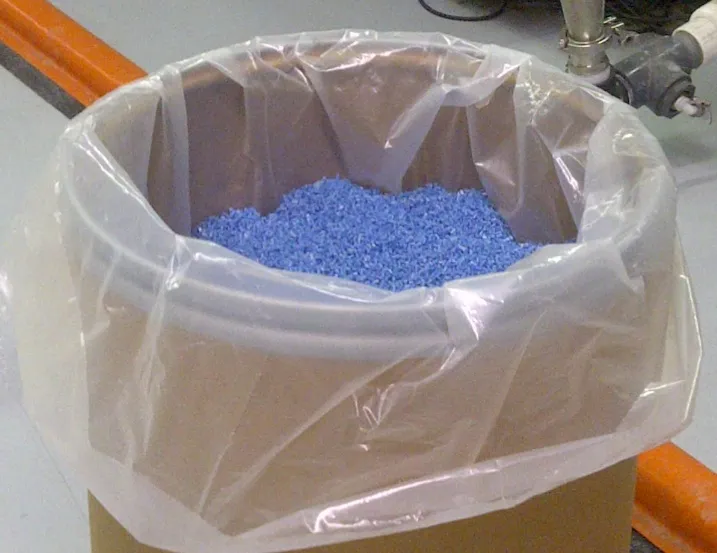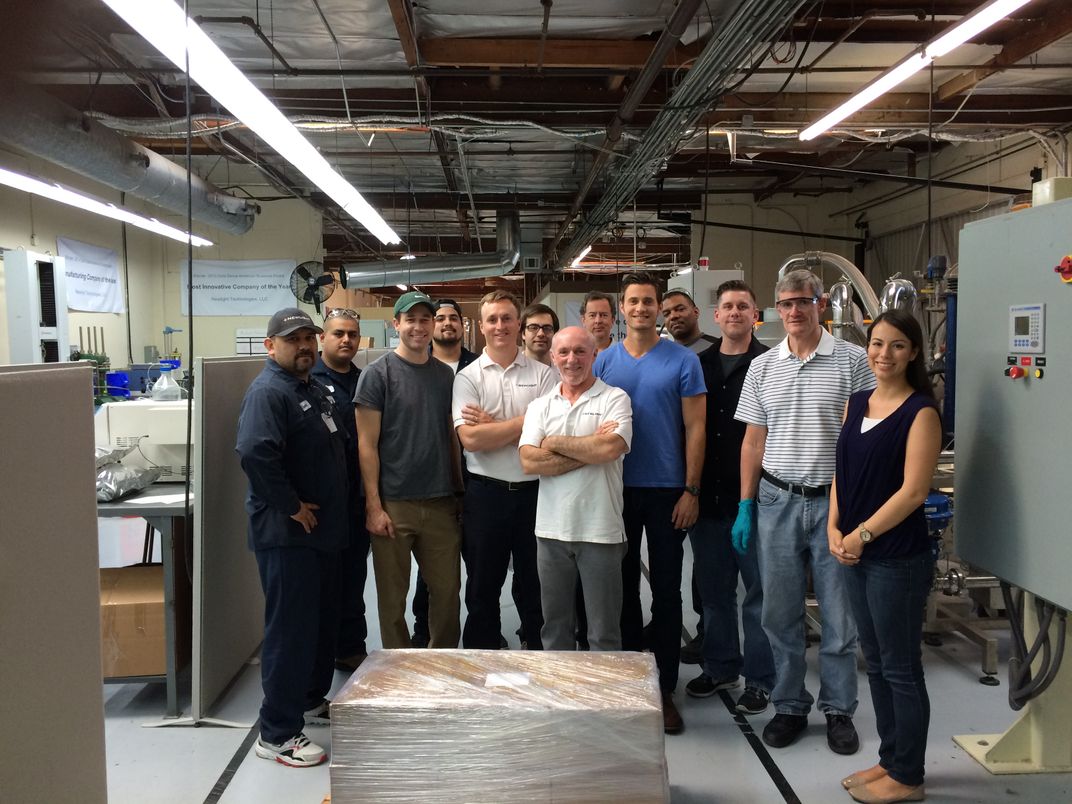Creating Plastic From Greenhouse Gases
Newlight Technologies is turning carbon emissions into plastic for everyday items
:focal(935x467:936x468)/https://tf-cmsv2-smithsonianmag-media.s3.amazonaws.com/filer/ef/cf/efcf6e78-7578-46b9-b402-b5e6458107c7/newlight_team.jpg)
For his senior thesis at Princeton, Mark Herrema studied farm subsidies and devised a market-driven solution to world hunger. Nothing seems too tall an order for the determined entrepreneur, who majored in politics.
Herrema, 33, has since shifted his focus to climate change—specifically, finding a way to capture greenhouse gases and put them to good use. He and Kenton Kimmel, a high school classmate, founded the Irvine, California-based company Newlight Technologies in 2003. After years of research, the team unveiled a way to produce plastic from carbon emissions that is actually more affordably priced than oil-based plastics. The "secret sauce" is a biocatalyst that combines air and methane, and reassembles all of the carbon, hydrogen and oxygen molecules into a thermoplastic the makers call AirCarbon.
Herrema shares his story with Smithsonian.com.
Let's start with the problem. What problem are you trying to fix?
Newlight started in 2003 with a question. Instead of looking at carbon emissions as a problem, what if we could use carbon emissions as a raw material to make materials, and what if those materials could outcompete oil-based materials on price and performance?
If we could do that, we would have a powerful process to address two issues: first, oil dependency, by replacing oil with captured carbon emissions, and second, climate change, by creating a market-driven carbon capture platform. What if the world was competing for the use of carbon emissions as a resource? There are few things we can imagine that would be so powerful in addressing climate change.
So, what exactly is Newlight Technologies? Could you give me your elevator pitch?
Newlight was founded to realize this vision. The net result, after over a decade of research and development, is AirCarbon, a thermoplastic material made by combining air and captured methane-based carbon emissions that would otherwise become part of the air. The material is as strong as oil-based plastics and significantly less expensive.
How exactly do you make the plastic?
The production process starts with methane emissions generated at places like landfills, farms, water treatment plants and energy production facilities—anywhere that methane is being emitted where it would otherwise be vented or flared. The first thing we do is capture that methane.
For example, at a farm, organic material is often held in a confined area, such as a tank, where it produces methane, and this methane is vented or routed into a pipe and eventually combusted, with essentially 100 percent of the carbon being released to air. In our process, instead of letting that pipe vent or feed a combustion device, we redirect the pipe to our conversion reactor. Inside the reactor, we mix the methane emissions with water, air and our biocatalyst. Here, the biocatalyst pulls oxygen out of the air, and carbon and hydrogen out of the methane, and combines those molecules to make a long-chain thermoplastic polymer molecule, called AirCarbon.
Next, we remove AirCarbon from the reactor, and after a downstream processing step, melt it into a pellet, where it can then be processed into shapes and used to replace oil-based plastics.

How were you able to make this process cost-effective?
The basic science to convert methane into thermoplastic polymers existed for many decades. Unfortunately, while the science existed, the key challenge, and the reason the process had never been commercialized, was cost. Prior to Newlight, the cost to produce polymers from methane emissions was about 2 to 3 times higher than the cost to produce oil-based plastics. Unfortunately, very few companies can afford to use a material at that price level. So, our founding challenge was: how do we carry out this process in such a way where we can outcompete oil-based plastics on price? Ultimately, our key breakthrough was our biocatalyst.
Specifically, in the past, all biocatalysts were self-limiting, meaning that they could only make a certain amount of polymer before they would turn themselves off and make carbon dioxide instead of polymer. Numerically, to make one kilogram of plastic, you needed to make one kilogram of biocatalyst, and that was the maximum yield, which rendered the production cost very expensive.
Over the course of about ten years of work, we developed a new kind of biocatalyst that does not turn itself off. Every kilogram of biocatalyst we make produces about nine kilograms of polymer—nine times more material for the same input than previous options, enabling Newlight to manufacture polymer from greenhouse gases at a price point that features a double-digit percentage cost reduction compared to the cost to produce plastics from oil.
How did you come up with this concept?
I read an Los Angeles Times article about methane emissions from cows in 2003, called “Getting the Cows to Cool It.” The article described the precise volume of methane—634 quarts—emitted per cow per day, and this number started a chain of questions: how much methane does a farm produce? What about a county, a state, a landfill or an energy facility?
What had seemed like an abstract concept of carbon emissions now seemed so real, so touchable. The burning question was, if so many of our materials are made from carbon, why are we letting all of this carbon go into the air? Why not use it to make materials, particularly materials that would otherwise be made from oil, like plastics?
I teamed up with Kenton Kimmel to found Newlight, and in 2006, Evan Creelman joined our team. For nine years, Newlight worked in radio-silence—no website, no public presence—because we said that until we could outcompete oil-based plastics on price, there was nothing to talk about.

How would you describe your success to date?
In August of 2013, ten years after our founding, Newlight commenced operations at the world’s first commercial-scale AirCarbon manufacturing facility in California, where we are combining air with methane from a farm to make AirCarbon thermoplastics.
Since Newlight’s commercial scale-up, AirCarbon has been used in a number of products, including chairs from KI, bags from Dell and cell phone cases from Sprint. In 2013, Newlight had five product applications. Within 12 months of our commercial scale-up, we grew to over 75 applications, and today we are working with over 60 Fortune 500 companies to launch AirCarbon in various products in the U.S., Europe and Asia, from automotive applications and electronics components, to bottles, caps and films.
Our focus today is on expansion, with our next benchmark step being to scale production up to 50 million pounds per year. One of the last major innovations in plastics production—Union Carbide's UNIPOL technology—reduced the capital and operating cost of plastics production process and grew from an idea to over 60 billion pounds per year in annual production. We see an equally significant step-change in cost savings, and we aim to achieve similar scale.
In parallel, our focus is building more conversion facilities, so that we can expand the AirCarbon production technology quickly and efficiently, at places like farms and landfills to the [fracking] flares of North Dakota and Texas, where the amount of carbon being flared and emitted every day—carbon that we could be converting into materials—is so intense that from space these rural areas light up the sky at night like Chicago or New York.

What impact do you see Newlight Technologies having on the reduction of greenhouse gas emissions?
When you hold AirCarbon in your hand, about 40 percent of the weight you feel is oxygen pulled from air and 60 percent is carbon and hydrogen from captured carbon emissions—carbon that would have otherwise become part of the air.
Our hope is that AirCarbon starts a paradigm shift, where we start to view greenhouse gas emissions as a resource, a raw material that can be used to produce the highest quality, most cost-advantaged, most sustainable materials in the world.
Do you think Newlight can help resolve the tension between those interested in restricting carbon emissions and those who feel such restrictions will be crippling to the economy? If so, how?
Absolutely. AirCarbon is one part Atlas Shrugged and one part An Inconvenient Truth. It is our belief that climate change is not going to be solved by subsidies or taxes. We think that the only way we are going to solve climate change, in the time and at the scale that is required, is through market-driven solutions, where consumers and brands are part of the solution, where the products we make cost less and capture carbon, and where we all participate in that.
Ultimately, what is so exciting to us about AirCarbon is that it changes the terms of the debate. If the reality is political deadlock, we have to stop fighting the same fight and focus on common ground and solutions. We can all agree that we would rather use domestic carbon sequestration than oil to make products, and we can all agree that we would rather use carbon capture materials that cost less than oil-based materials.
/https://tf-cmsv2-smithsonianmag-media.s3.amazonaws.com/accounts/headshot/profile.jpg)
/https://tf-cmsv2-smithsonianmag-media.s3.amazonaws.com/accounts/headshot/profile.jpg)